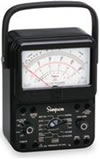How to measure resistance with a multimeter?
Note: Due to the wide variety and types of measuring instruments available, we are going to explain the most common method of measuring the resistance with a multimeter. In this case, the meter will be the analog multimeter, although it can also be used with the digital multimeter.
The resistance measurement range selector is different from the voltage and current range selectors. When the function selector is in ohms, the measured result is multiplied by the factor shown in the range (see picture).
Common ranges are: R x 1, R x 10, R x 100, R x 1K, R x 10K, R x 1M, where:
- K means Kilohms
- M means Megohms
Not all multimeters / VOM are created equal, so it is very important to look carefully at the range selector.
For example, consider the yellow color in the following image:
- If the multimeter scale reads 4.7 and the range is 1K or 1000, the multimeter would measure a resistance value of 4.7 x 1000 = 4700 ohms or 4.7K (kilo ohms).
- If the multimeter scale reads 2.5 and the range is 10 M or 10 000 000, the multimeter would measure a resistance value of 2.5 x 10 000 000 = 25 000 000 ohms or 25 M (megohms).
It is very important to select the correct function and range before making a measurement. If you make a mistake, you may damage the multimeter. There is another way if you want to measure a very low value resistor.
In addition, the analog multimeters have two knobs, one that allows you to set the needle to zero (rest position) and the other that allows you to set the reading to zero ohms (0).
To do this, do the following:
- Set the function selector to ohms
- Set the range selector to x 1
- Connect the test leads
At the end of the previous process, the needle should be at 0 ohms; if not, make an adjustment with the knob, touch the multimeter leads together, and check that it reads 0 ohms.
More Instruments & Measurements Tutorials
- Multimeter - VOM - Tester
- Measuring resistance with an analog multimeter
- Low resistance measurement
- Measuring the resistance of sensitive components
- What is a Wheatstone bridge circuit?
- How to extend analog multimeter voltage range?
- Testing diodes and transistors with a multimeter
- What is a logic probe?
- Scientific Notation - Engineering Notation
- kWh - cost of electrical energy
- DIY circuit diagrams for test equipment






